Business Ethics Report: Toyota's Ethical Failures and Recall Scandal
VerifiedAdded on 2022/09/28
|10
|2978
|25
Report
AI Summary
This report analyzes the ethical issues surrounding Toyota's accelerator pedal recall, focusing on the company's response to the sticky gas pedal issue and the subsequent recall of over 8.5 million vehicles. It explores the ethical implications at the company, macro, and individual levels, highlighting the importance of ethical standards and corporate social responsibility. The report examines Toyota's negligence in addressing safety defects, its reluctance to accept responsibility, and its failure to prioritize customer welfare over profit and reputation. It evaluates the company's adherence to utilitarianism and its use of the G4 guidelines for CSR practices, concluding that Toyota's actions demonstrated a significant weakness in its ethical decision-making and a disregard for its stakeholders. The report also discusses the impact of the scandal on Toyota's reputation and the importance of centralized data governance and decentralized execution in managing such crises, and the need for a causal level of moral responsibility. This report is a valuable resource for students studying business ethics and corporate governance, and provides insights into the ethical challenges faced by large organizations and the importance of ethical business practices.
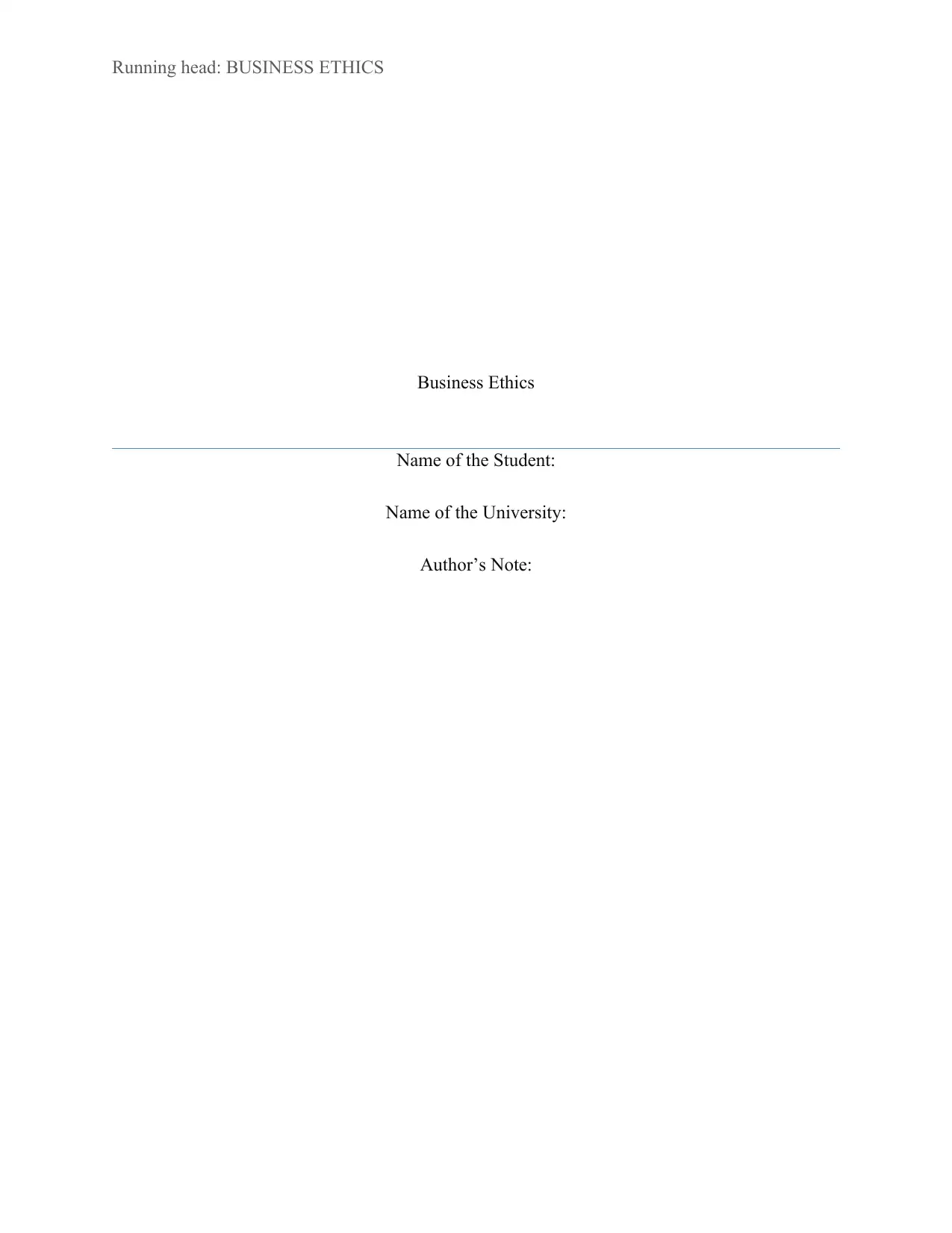
Running head: BUSINESS ETHICS
Business Ethics
Name of the Student:
Name of the University:
Author’s Note:
Business Ethics
Name of the Student:
Name of the University:
Author’s Note:
Paraphrase This Document
Need a fresh take? Get an instant paraphrase of this document with our AI Paraphraser
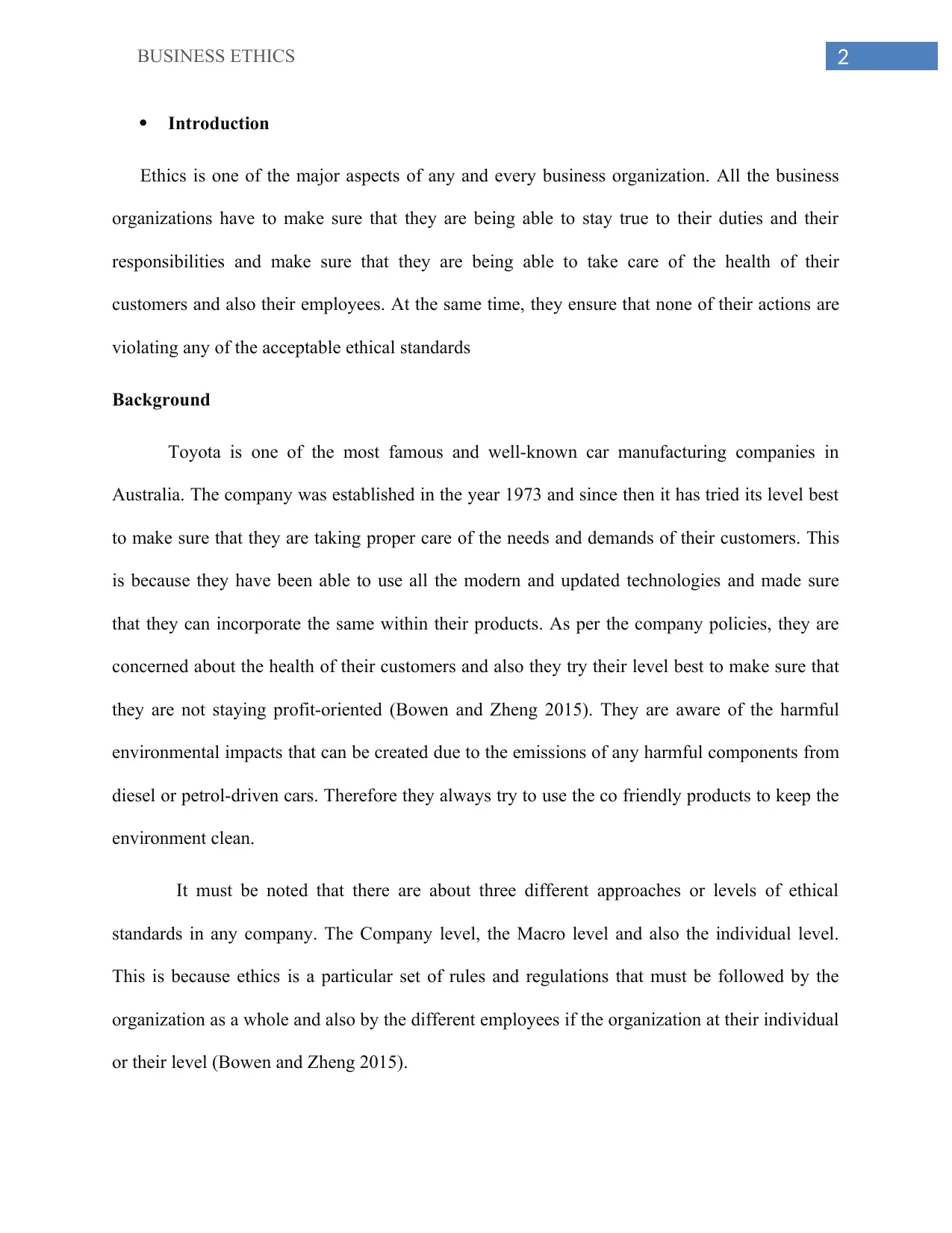
2BUSINESS ETHICS
Introduction
Ethics is one of the major aspects of any and every business organization. All the business
organizations have to make sure that they are being able to stay true to their duties and their
responsibilities and make sure that they are being able to take care of the health of their
customers and also their employees. At the same time, they ensure that none of their actions are
violating any of the acceptable ethical standards
Background
Toyota is one of the most famous and well-known car manufacturing companies in
Australia. The company was established in the year 1973 and since then it has tried its level best
to make sure that they are taking proper care of the needs and demands of their customers. This
is because they have been able to use all the modern and updated technologies and made sure
that they can incorporate the same within their products. As per the company policies, they are
concerned about the health of their customers and also they try their level best to make sure that
they are not staying profit-oriented (Bowen and Zheng 2015). They are aware of the harmful
environmental impacts that can be created due to the emissions of any harmful components from
diesel or petrol-driven cars. Therefore they always try to use the co friendly products to keep the
environment clean.
It must be noted that there are about three different approaches or levels of ethical
standards in any company. The Company level, the Macro level and also the individual level.
This is because ethics is a particular set of rules and regulations that must be followed by the
organization as a whole and also by the different employees if the organization at their individual
or their level (Bowen and Zheng 2015).
Introduction
Ethics is one of the major aspects of any and every business organization. All the business
organizations have to make sure that they are being able to stay true to their duties and their
responsibilities and make sure that they are being able to take care of the health of their
customers and also their employees. At the same time, they ensure that none of their actions are
violating any of the acceptable ethical standards
Background
Toyota is one of the most famous and well-known car manufacturing companies in
Australia. The company was established in the year 1973 and since then it has tried its level best
to make sure that they are taking proper care of the needs and demands of their customers. This
is because they have been able to use all the modern and updated technologies and made sure
that they can incorporate the same within their products. As per the company policies, they are
concerned about the health of their customers and also they try their level best to make sure that
they are not staying profit-oriented (Bowen and Zheng 2015). They are aware of the harmful
environmental impacts that can be created due to the emissions of any harmful components from
diesel or petrol-driven cars. Therefore they always try to use the co friendly products to keep the
environment clean.
It must be noted that there are about three different approaches or levels of ethical
standards in any company. The Company level, the Macro level and also the individual level.
This is because ethics is a particular set of rules and regulations that must be followed by the
organization as a whole and also by the different employees if the organization at their individual
or their level (Bowen and Zheng 2015).
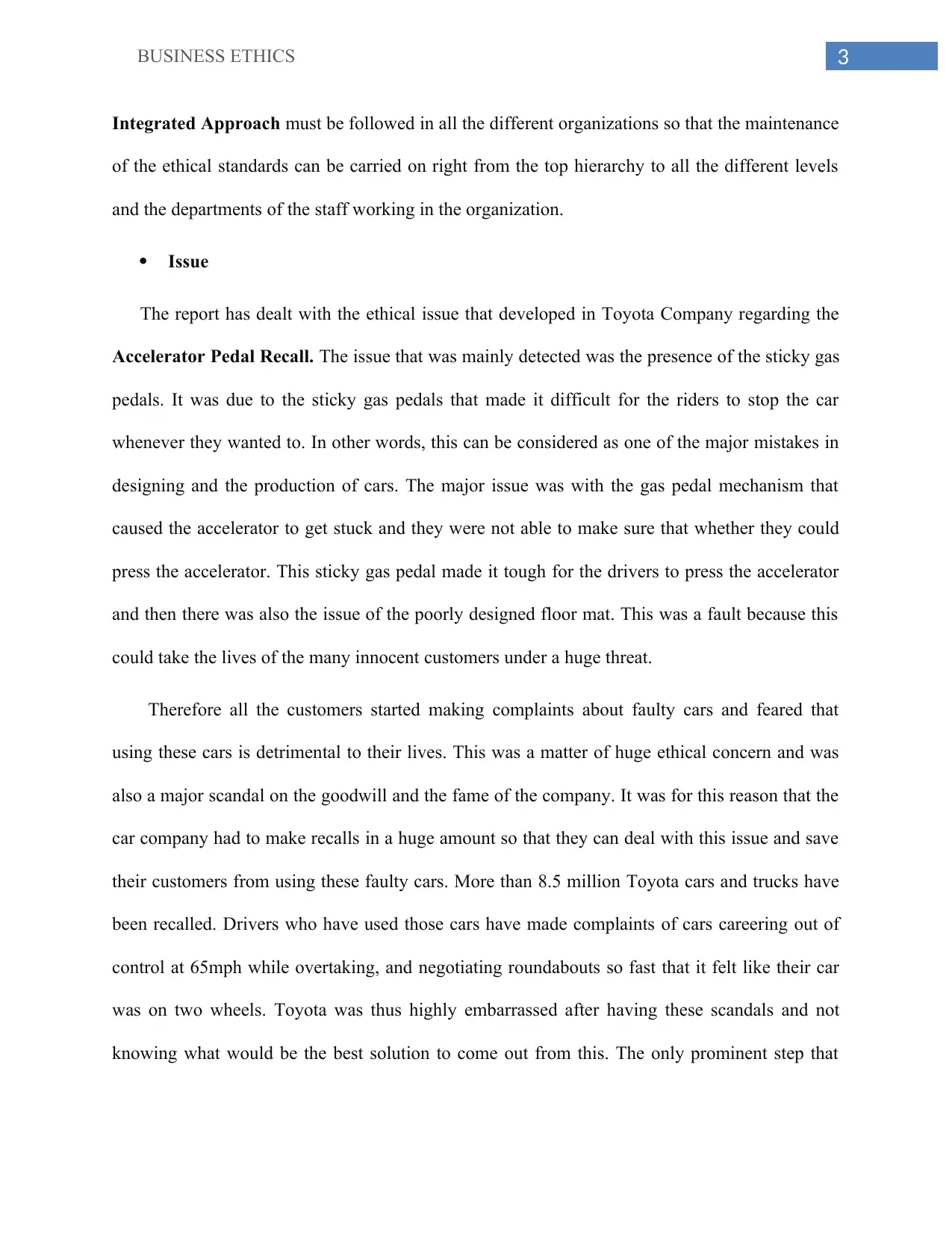
3BUSINESS ETHICS
Integrated Approach must be followed in all the different organizations so that the maintenance
of the ethical standards can be carried on right from the top hierarchy to all the different levels
and the departments of the staff working in the organization.
Issue
The report has dealt with the ethical issue that developed in Toyota Company regarding the
Accelerator Pedal Recall. The issue that was mainly detected was the presence of the sticky gas
pedals. It was due to the sticky gas pedals that made it difficult for the riders to stop the car
whenever they wanted to. In other words, this can be considered as one of the major mistakes in
designing and the production of cars. The major issue was with the gas pedal mechanism that
caused the accelerator to get stuck and they were not able to make sure that whether they could
press the accelerator. This sticky gas pedal made it tough for the drivers to press the accelerator
and then there was also the issue of the poorly designed floor mat. This was a fault because this
could take the lives of the many innocent customers under a huge threat.
Therefore all the customers started making complaints about faulty cars and feared that
using these cars is detrimental to their lives. This was a matter of huge ethical concern and was
also a major scandal on the goodwill and the fame of the company. It was for this reason that the
car company had to make recalls in a huge amount so that they can deal with this issue and save
their customers from using these faulty cars. More than 8.5 million Toyota cars and trucks have
been recalled. Drivers who have used those cars have made complaints of cars careering out of
control at 65mph while overtaking, and negotiating roundabouts so fast that it felt like their car
was on two wheels. Toyota was thus highly embarrassed after having these scandals and not
knowing what would be the best solution to come out from this. The only prominent step that
Integrated Approach must be followed in all the different organizations so that the maintenance
of the ethical standards can be carried on right from the top hierarchy to all the different levels
and the departments of the staff working in the organization.
Issue
The report has dealt with the ethical issue that developed in Toyota Company regarding the
Accelerator Pedal Recall. The issue that was mainly detected was the presence of the sticky gas
pedals. It was due to the sticky gas pedals that made it difficult for the riders to stop the car
whenever they wanted to. In other words, this can be considered as one of the major mistakes in
designing and the production of cars. The major issue was with the gas pedal mechanism that
caused the accelerator to get stuck and they were not able to make sure that whether they could
press the accelerator. This sticky gas pedal made it tough for the drivers to press the accelerator
and then there was also the issue of the poorly designed floor mat. This was a fault because this
could take the lives of the many innocent customers under a huge threat.
Therefore all the customers started making complaints about faulty cars and feared that
using these cars is detrimental to their lives. This was a matter of huge ethical concern and was
also a major scandal on the goodwill and the fame of the company. It was for this reason that the
car company had to make recalls in a huge amount so that they can deal with this issue and save
their customers from using these faulty cars. More than 8.5 million Toyota cars and trucks have
been recalled. Drivers who have used those cars have made complaints of cars careering out of
control at 65mph while overtaking, and negotiating roundabouts so fast that it felt like their car
was on two wheels. Toyota was thus highly embarrassed after having these scandals and not
knowing what would be the best solution to come out from this. The only prominent step that
⊘ This is a preview!⊘
Do you want full access?
Subscribe today to unlock all pages.

Trusted by 1+ million students worldwide
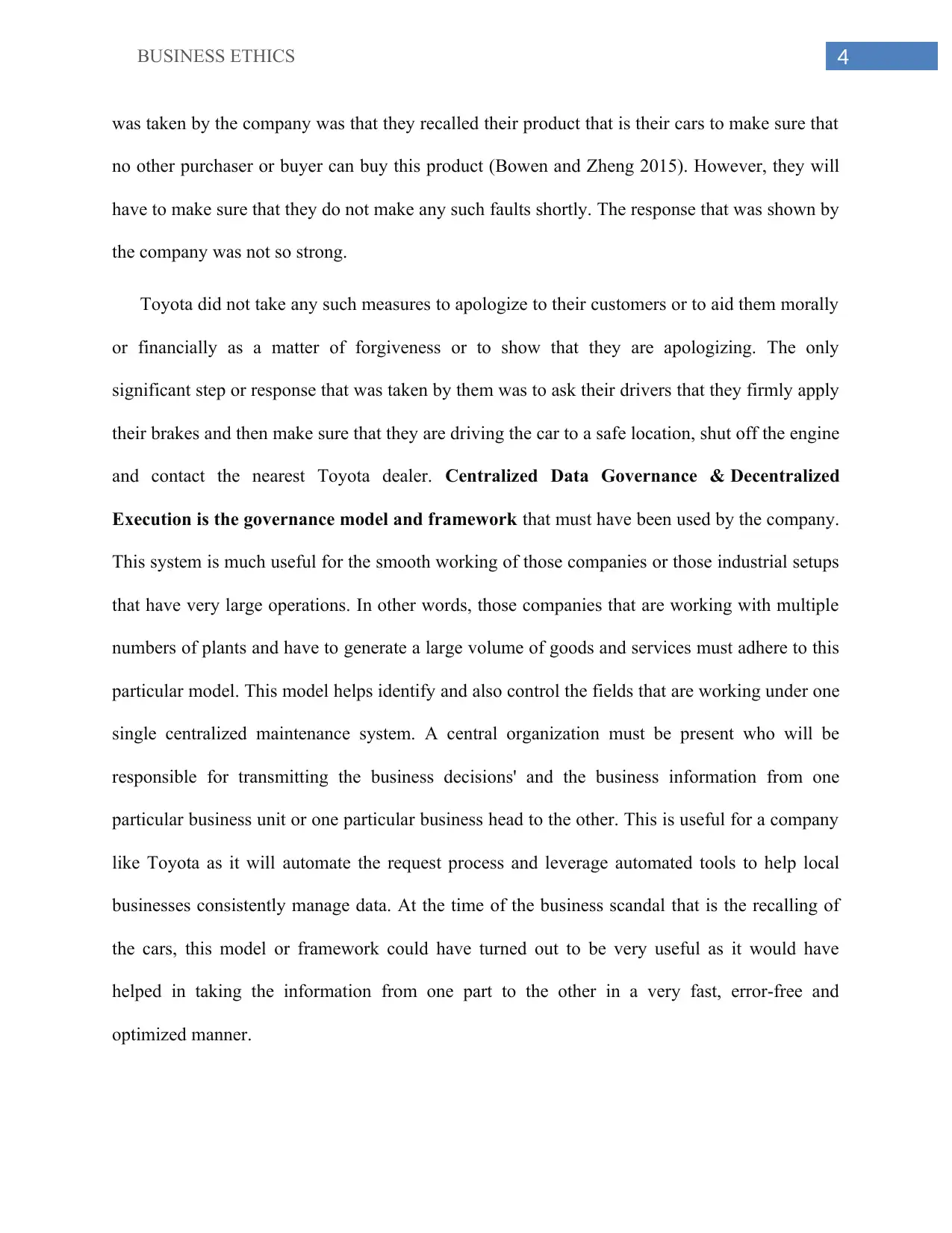
4BUSINESS ETHICS
was taken by the company was that they recalled their product that is their cars to make sure that
no other purchaser or buyer can buy this product (Bowen and Zheng 2015). However, they will
have to make sure that they do not make any such faults shortly. The response that was shown by
the company was not so strong.
Toyota did not take any such measures to apologize to their customers or to aid them morally
or financially as a matter of forgiveness or to show that they are apologizing. The only
significant step or response that was taken by them was to ask their drivers that they firmly apply
their brakes and then make sure that they are driving the car to a safe location, shut off the engine
and contact the nearest Toyota dealer. Centralized Data Governance & Decentralized
Execution is the governance model and framework that must have been used by the company.
This system is much useful for the smooth working of those companies or those industrial setups
that have very large operations. In other words, those companies that are working with multiple
numbers of plants and have to generate a large volume of goods and services must adhere to this
particular model. This model helps identify and also control the fields that are working under one
single centralized maintenance system. A central organization must be present who will be
responsible for transmitting the business decisions' and the business information from one
particular business unit or one particular business head to the other. This is useful for a company
like Toyota as it will automate the request process and leverage automated tools to help local
businesses consistently manage data. At the time of the business scandal that is the recalling of
the cars, this model or framework could have turned out to be very useful as it would have
helped in taking the information from one part to the other in a very fast, error-free and
optimized manner.
was taken by the company was that they recalled their product that is their cars to make sure that
no other purchaser or buyer can buy this product (Bowen and Zheng 2015). However, they will
have to make sure that they do not make any such faults shortly. The response that was shown by
the company was not so strong.
Toyota did not take any such measures to apologize to their customers or to aid them morally
or financially as a matter of forgiveness or to show that they are apologizing. The only
significant step or response that was taken by them was to ask their drivers that they firmly apply
their brakes and then make sure that they are driving the car to a safe location, shut off the engine
and contact the nearest Toyota dealer. Centralized Data Governance & Decentralized
Execution is the governance model and framework that must have been used by the company.
This system is much useful for the smooth working of those companies or those industrial setups
that have very large operations. In other words, those companies that are working with multiple
numbers of plants and have to generate a large volume of goods and services must adhere to this
particular model. This model helps identify and also control the fields that are working under one
single centralized maintenance system. A central organization must be present who will be
responsible for transmitting the business decisions' and the business information from one
particular business unit or one particular business head to the other. This is useful for a company
like Toyota as it will automate the request process and leverage automated tools to help local
businesses consistently manage data. At the time of the business scandal that is the recalling of
the cars, this model or framework could have turned out to be very useful as it would have
helped in taking the information from one part to the other in a very fast, error-free and
optimized manner.
Paraphrase This Document
Need a fresh take? Get an instant paraphrase of this document with our AI Paraphraser
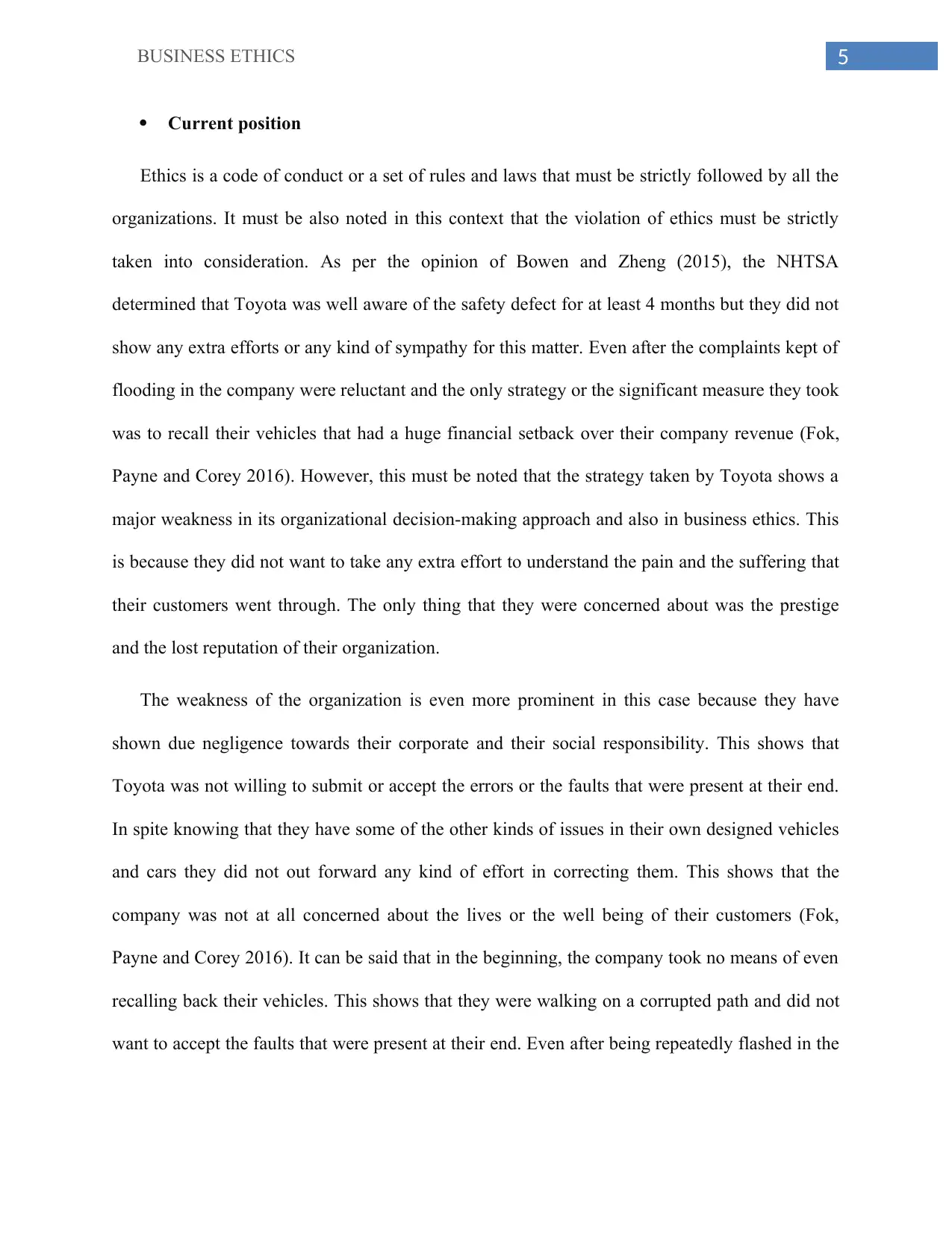
5BUSINESS ETHICS
Current position
Ethics is a code of conduct or a set of rules and laws that must be strictly followed by all the
organizations. It must be also noted in this context that the violation of ethics must be strictly
taken into consideration. As per the opinion of Bowen and Zheng (2015), the NHTSA
determined that Toyota was well aware of the safety defect for at least 4 months but they did not
show any extra efforts or any kind of sympathy for this matter. Even after the complaints kept of
flooding in the company were reluctant and the only strategy or the significant measure they took
was to recall their vehicles that had a huge financial setback over their company revenue (Fok,
Payne and Corey 2016). However, this must be noted that the strategy taken by Toyota shows a
major weakness in its organizational decision-making approach and also in business ethics. This
is because they did not want to take any extra effort to understand the pain and the suffering that
their customers went through. The only thing that they were concerned about was the prestige
and the lost reputation of their organization.
The weakness of the organization is even more prominent in this case because they have
shown due negligence towards their corporate and their social responsibility. This shows that
Toyota was not willing to submit or accept the errors or the faults that were present at their end.
In spite knowing that they have some of the other kinds of issues in their own designed vehicles
and cars they did not out forward any kind of effort in correcting them. This shows that the
company was not at all concerned about the lives or the well being of their customers (Fok,
Payne and Corey 2016). It can be said that in the beginning, the company took no means of even
recalling back their vehicles. This shows that they were walking on a corrupted path and did not
want to accept the faults that were present at their end. Even after being repeatedly flashed in the
Current position
Ethics is a code of conduct or a set of rules and laws that must be strictly followed by all the
organizations. It must be also noted in this context that the violation of ethics must be strictly
taken into consideration. As per the opinion of Bowen and Zheng (2015), the NHTSA
determined that Toyota was well aware of the safety defect for at least 4 months but they did not
show any extra efforts or any kind of sympathy for this matter. Even after the complaints kept of
flooding in the company were reluctant and the only strategy or the significant measure they took
was to recall their vehicles that had a huge financial setback over their company revenue (Fok,
Payne and Corey 2016). However, this must be noted that the strategy taken by Toyota shows a
major weakness in its organizational decision-making approach and also in business ethics. This
is because they did not want to take any extra effort to understand the pain and the suffering that
their customers went through. The only thing that they were concerned about was the prestige
and the lost reputation of their organization.
The weakness of the organization is even more prominent in this case because they have
shown due negligence towards their corporate and their social responsibility. This shows that
Toyota was not willing to submit or accept the errors or the faults that were present at their end.
In spite knowing that they have some of the other kinds of issues in their own designed vehicles
and cars they did not out forward any kind of effort in correcting them. This shows that the
company was not at all concerned about the lives or the well being of their customers (Fok,
Payne and Corey 2016). It can be said that in the beginning, the company took no means of even
recalling back their vehicles. This shows that they were walking on a corrupted path and did not
want to accept the faults that were present at their end. Even after being repeatedly flashed in the
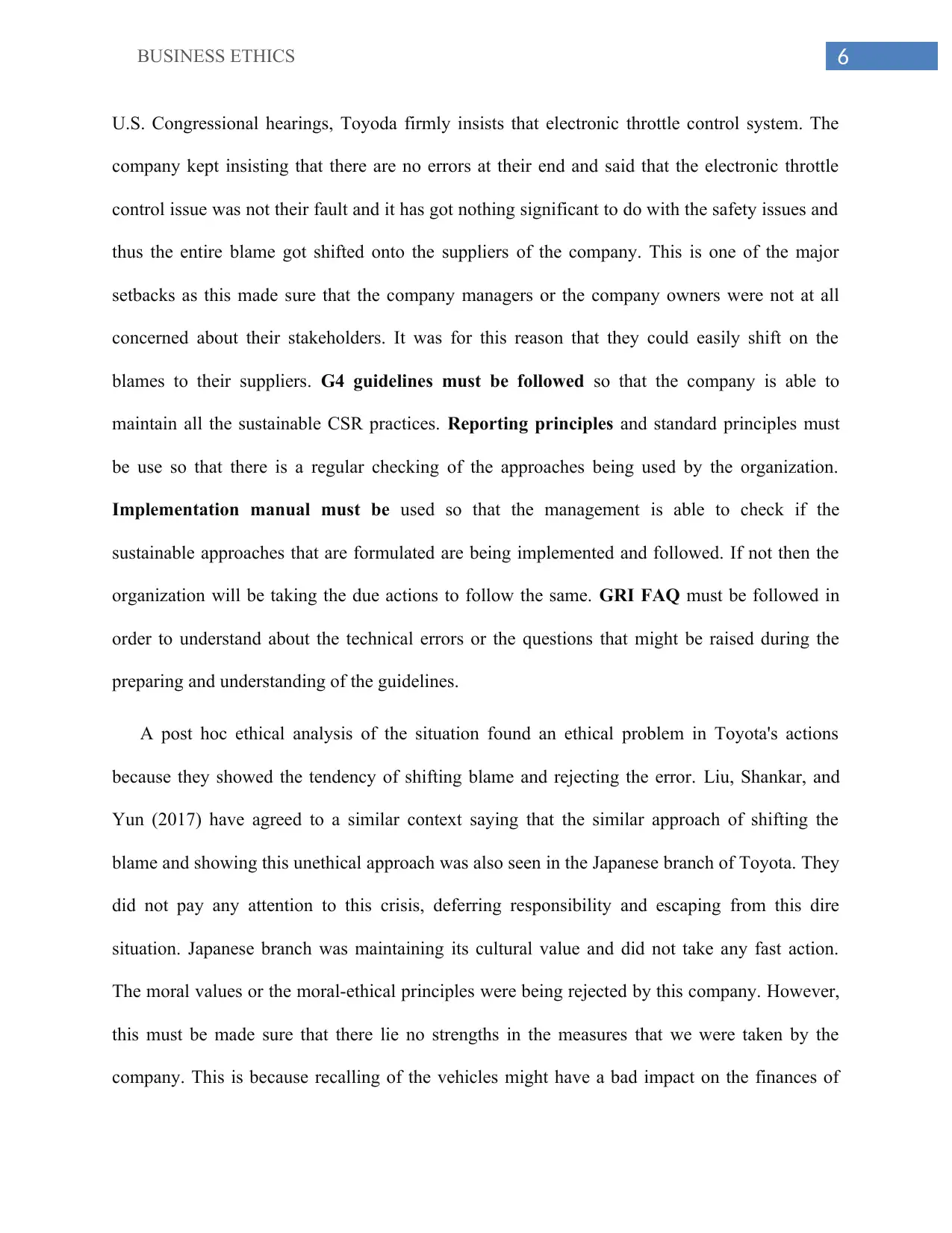
6BUSINESS ETHICS
U.S. Congressional hearings, Toyoda firmly insists that electronic throttle control system. The
company kept insisting that there are no errors at their end and said that the electronic throttle
control issue was not their fault and it has got nothing significant to do with the safety issues and
thus the entire blame got shifted onto the suppliers of the company. This is one of the major
setbacks as this made sure that the company managers or the company owners were not at all
concerned about their stakeholders. It was for this reason that they could easily shift on the
blames to their suppliers. G4 guidelines must be followed so that the company is able to
maintain all the sustainable CSR practices. Reporting principles and standard principles must
be use so that there is a regular checking of the approaches being used by the organization.
Implementation manual must be used so that the management is able to check if the
sustainable approaches that are formulated are being implemented and followed. If not then the
organization will be taking the due actions to follow the same. GRI FAQ must be followed in
order to understand about the technical errors or the questions that might be raised during the
preparing and understanding of the guidelines.
A post hoc ethical analysis of the situation found an ethical problem in Toyota's actions
because they showed the tendency of shifting blame and rejecting the error. Liu, Shankar, and
Yun (2017) have agreed to a similar context saying that the similar approach of shifting the
blame and showing this unethical approach was also seen in the Japanese branch of Toyota. They
did not pay any attention to this crisis, deferring responsibility and escaping from this dire
situation. Japanese branch was maintaining its cultural value and did not take any fast action.
The moral values or the moral-ethical principles were being rejected by this company. However,
this must be made sure that there lie no strengths in the measures that we were taken by the
company. This is because recalling of the vehicles might have a bad impact on the finances of
U.S. Congressional hearings, Toyoda firmly insists that electronic throttle control system. The
company kept insisting that there are no errors at their end and said that the electronic throttle
control issue was not their fault and it has got nothing significant to do with the safety issues and
thus the entire blame got shifted onto the suppliers of the company. This is one of the major
setbacks as this made sure that the company managers or the company owners were not at all
concerned about their stakeholders. It was for this reason that they could easily shift on the
blames to their suppliers. G4 guidelines must be followed so that the company is able to
maintain all the sustainable CSR practices. Reporting principles and standard principles must
be use so that there is a regular checking of the approaches being used by the organization.
Implementation manual must be used so that the management is able to check if the
sustainable approaches that are formulated are being implemented and followed. If not then the
organization will be taking the due actions to follow the same. GRI FAQ must be followed in
order to understand about the technical errors or the questions that might be raised during the
preparing and understanding of the guidelines.
A post hoc ethical analysis of the situation found an ethical problem in Toyota's actions
because they showed the tendency of shifting blame and rejecting the error. Liu, Shankar, and
Yun (2017) have agreed to a similar context saying that the similar approach of shifting the
blame and showing this unethical approach was also seen in the Japanese branch of Toyota. They
did not pay any attention to this crisis, deferring responsibility and escaping from this dire
situation. Japanese branch was maintaining its cultural value and did not take any fast action.
The moral values or the moral-ethical principles were being rejected by this company. However,
this must be made sure that there lie no strengths in the measures that we were taken by the
company. This is because recalling of the vehicles might have a bad impact on the finances of
⊘ This is a preview!⊘
Do you want full access?
Subscribe today to unlock all pages.

Trusted by 1+ million students worldwide
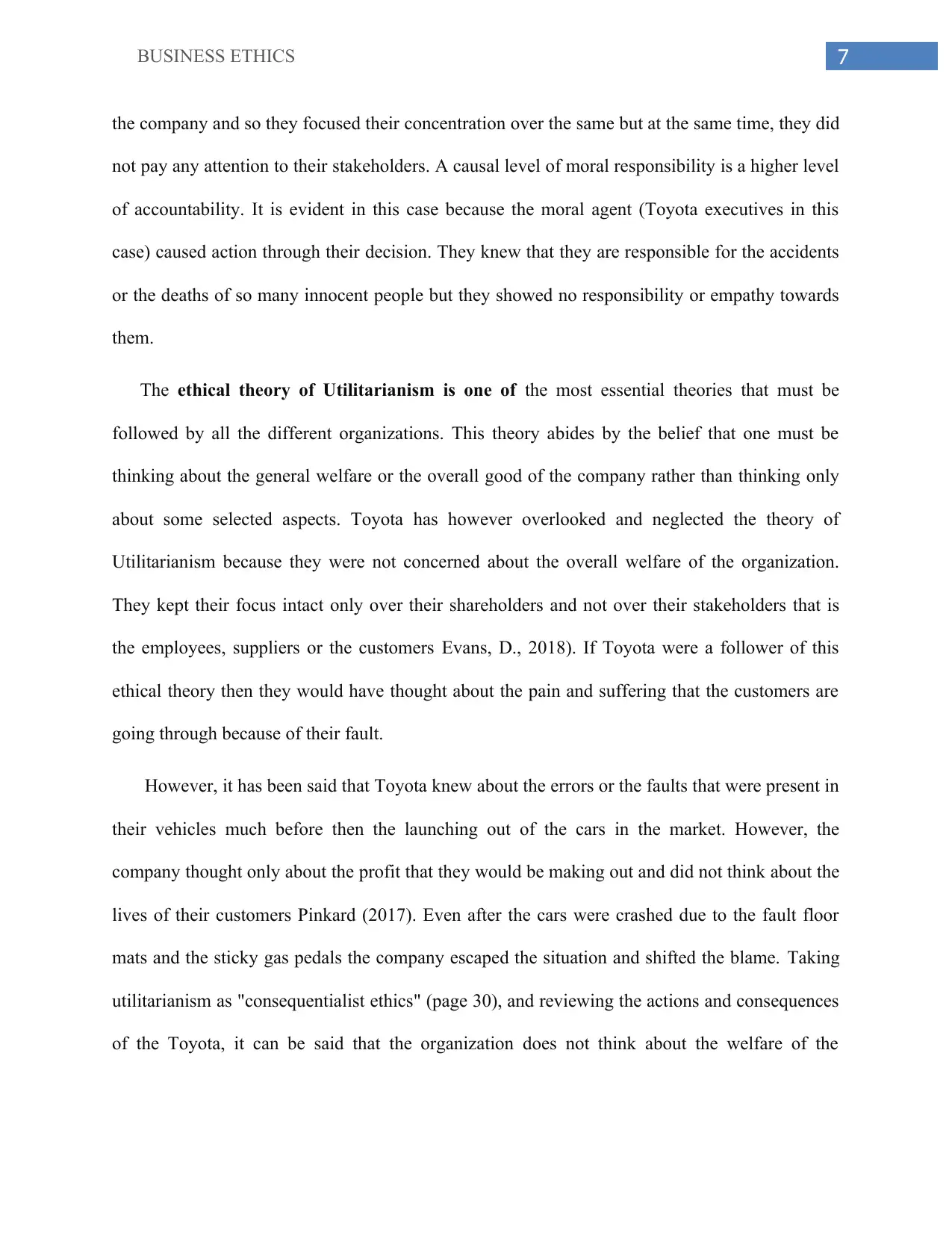
7BUSINESS ETHICS
the company and so they focused their concentration over the same but at the same time, they did
not pay any attention to their stakeholders. A causal level of moral responsibility is a higher level
of accountability. It is evident in this case because the moral agent (Toyota executives in this
case) caused action through their decision. They knew that they are responsible for the accidents
or the deaths of so many innocent people but they showed no responsibility or empathy towards
them.
The ethical theory of Utilitarianism is one of the most essential theories that must be
followed by all the different organizations. This theory abides by the belief that one must be
thinking about the general welfare or the overall good of the company rather than thinking only
about some selected aspects. Toyota has however overlooked and neglected the theory of
Utilitarianism because they were not concerned about the overall welfare of the organization.
They kept their focus intact only over their shareholders and not over their stakeholders that is
the employees, suppliers or the customers Evans, D., 2018). If Toyota were a follower of this
ethical theory then they would have thought about the pain and suffering that the customers are
going through because of their fault.
However, it has been said that Toyota knew about the errors or the faults that were present in
their vehicles much before then the launching out of the cars in the market. However, the
company thought only about the profit that they would be making out and did not think about the
lives of their customers Pinkard (2017). Even after the cars were crashed due to the fault floor
mats and the sticky gas pedals the company escaped the situation and shifted the blame. Taking
utilitarianism as "consequentialist ethics" (page 30), and reviewing the actions and consequences
of the Toyota, it can be said that the organization does not think about the welfare of the
the company and so they focused their concentration over the same but at the same time, they did
not pay any attention to their stakeholders. A causal level of moral responsibility is a higher level
of accountability. It is evident in this case because the moral agent (Toyota executives in this
case) caused action through their decision. They knew that they are responsible for the accidents
or the deaths of so many innocent people but they showed no responsibility or empathy towards
them.
The ethical theory of Utilitarianism is one of the most essential theories that must be
followed by all the different organizations. This theory abides by the belief that one must be
thinking about the general welfare or the overall good of the company rather than thinking only
about some selected aspects. Toyota has however overlooked and neglected the theory of
Utilitarianism because they were not concerned about the overall welfare of the organization.
They kept their focus intact only over their shareholders and not over their stakeholders that is
the employees, suppliers or the customers Evans, D., 2018). If Toyota were a follower of this
ethical theory then they would have thought about the pain and suffering that the customers are
going through because of their fault.
However, it has been said that Toyota knew about the errors or the faults that were present in
their vehicles much before then the launching out of the cars in the market. However, the
company thought only about the profit that they would be making out and did not think about the
lives of their customers Pinkard (2017). Even after the cars were crashed due to the fault floor
mats and the sticky gas pedals the company escaped the situation and shifted the blame. Taking
utilitarianism as "consequentialist ethics" (page 30), and reviewing the actions and consequences
of the Toyota, it can be said that the organization does not think about the welfare of the
Paraphrase This Document
Need a fresh take? Get an instant paraphrase of this document with our AI Paraphraser
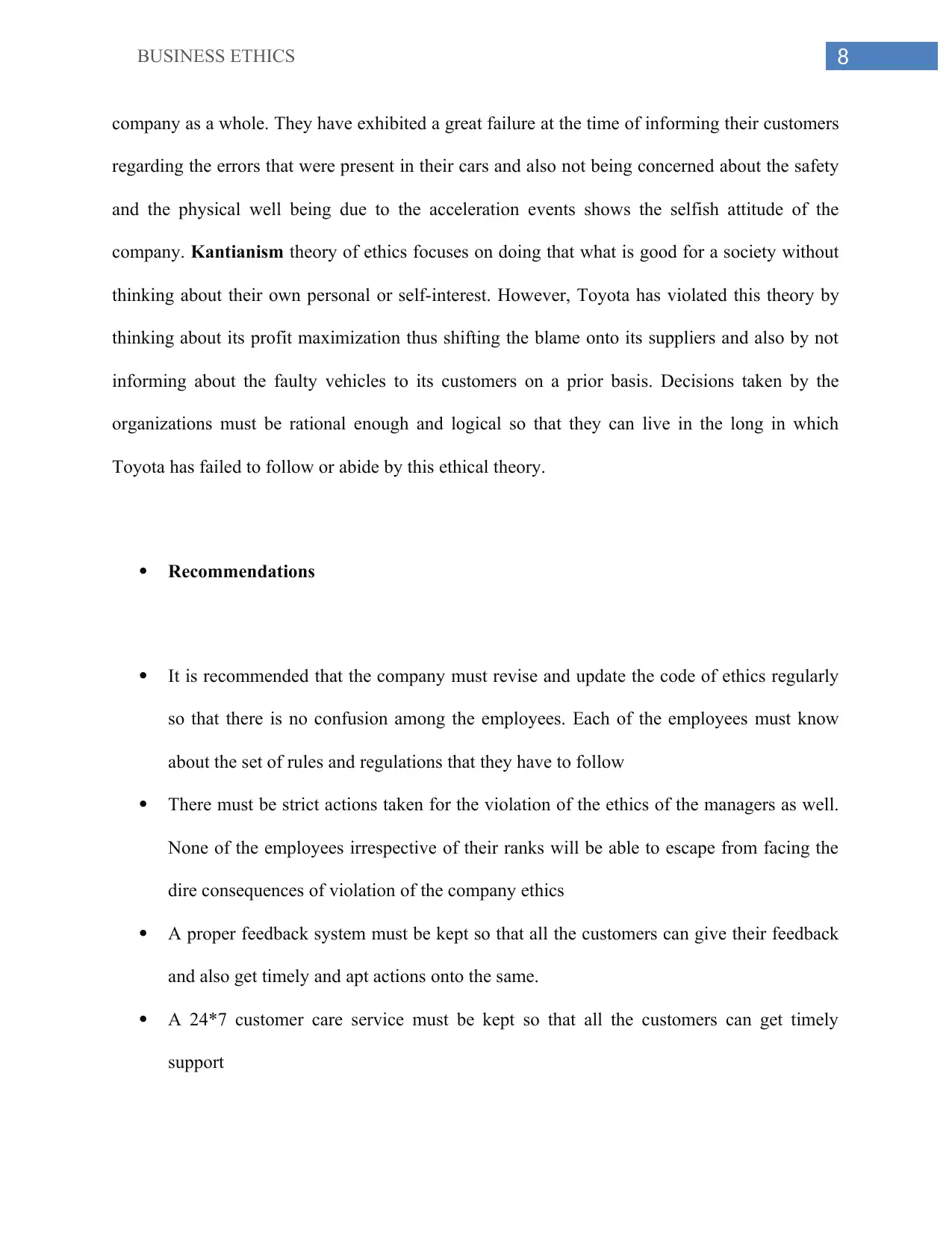
8BUSINESS ETHICS
company as a whole. They have exhibited a great failure at the time of informing their customers
regarding the errors that were present in their cars and also not being concerned about the safety
and the physical well being due to the acceleration events shows the selfish attitude of the
company. Kantianism theory of ethics focuses on doing that what is good for a society without
thinking about their own personal or self-interest. However, Toyota has violated this theory by
thinking about its profit maximization thus shifting the blame onto its suppliers and also by not
informing about the faulty vehicles to its customers on a prior basis. Decisions taken by the
organizations must be rational enough and logical so that they can live in the long in which
Toyota has failed to follow or abide by this ethical theory.
Recommendations
It is recommended that the company must revise and update the code of ethics regularly
so that there is no confusion among the employees. Each of the employees must know
about the set of rules and regulations that they have to follow
There must be strict actions taken for the violation of the ethics of the managers as well.
None of the employees irrespective of their ranks will be able to escape from facing the
dire consequences of violation of the company ethics
A proper feedback system must be kept so that all the customers can give their feedback
and also get timely and apt actions onto the same.
A 24*7 customer care service must be kept so that all the customers can get timely
support
company as a whole. They have exhibited a great failure at the time of informing their customers
regarding the errors that were present in their cars and also not being concerned about the safety
and the physical well being due to the acceleration events shows the selfish attitude of the
company. Kantianism theory of ethics focuses on doing that what is good for a society without
thinking about their own personal or self-interest. However, Toyota has violated this theory by
thinking about its profit maximization thus shifting the blame onto its suppliers and also by not
informing about the faulty vehicles to its customers on a prior basis. Decisions taken by the
organizations must be rational enough and logical so that they can live in the long in which
Toyota has failed to follow or abide by this ethical theory.
Recommendations
It is recommended that the company must revise and update the code of ethics regularly
so that there is no confusion among the employees. Each of the employees must know
about the set of rules and regulations that they have to follow
There must be strict actions taken for the violation of the ethics of the managers as well.
None of the employees irrespective of their ranks will be able to escape from facing the
dire consequences of violation of the company ethics
A proper feedback system must be kept so that all the customers can give their feedback
and also get timely and apt actions onto the same.
A 24*7 customer care service must be kept so that all the customers can get timely
support
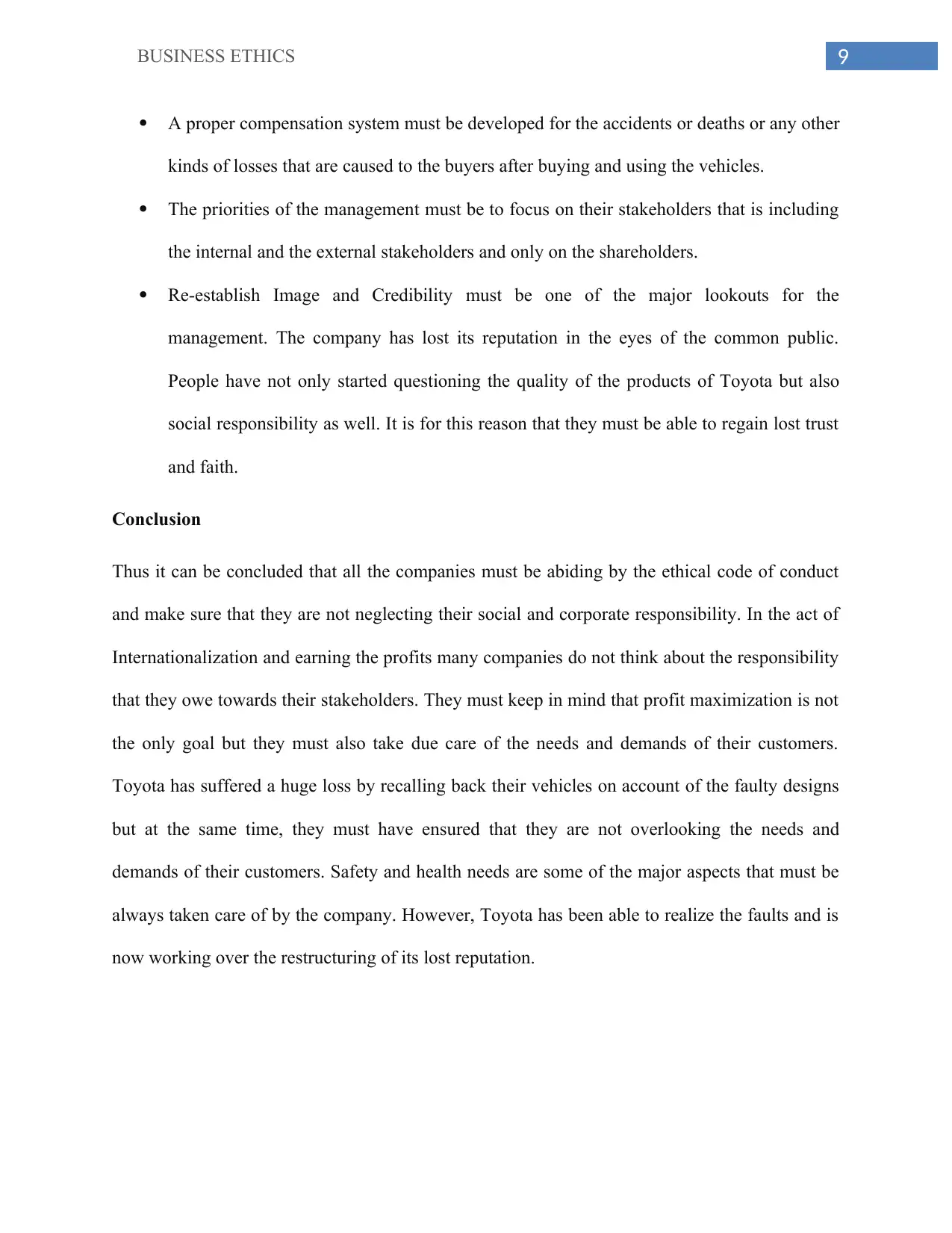
9BUSINESS ETHICS
A proper compensation system must be developed for the accidents or deaths or any other
kinds of losses that are caused to the buyers after buying and using the vehicles.
The priorities of the management must be to focus on their stakeholders that is including
the internal and the external stakeholders and only on the shareholders.
Re-establish Image and Credibility must be one of the major lookouts for the
management. The company has lost its reputation in the eyes of the common public.
People have not only started questioning the quality of the products of Toyota but also
social responsibility as well. It is for this reason that they must be able to regain lost trust
and faith.
Conclusion
Thus it can be concluded that all the companies must be abiding by the ethical code of conduct
and make sure that they are not neglecting their social and corporate responsibility. In the act of
Internationalization and earning the profits many companies do not think about the responsibility
that they owe towards their stakeholders. They must keep in mind that profit maximization is not
the only goal but they must also take due care of the needs and demands of their customers.
Toyota has suffered a huge loss by recalling back their vehicles on account of the faulty designs
but at the same time, they must have ensured that they are not overlooking the needs and
demands of their customers. Safety and health needs are some of the major aspects that must be
always taken care of by the company. However, Toyota has been able to realize the faults and is
now working over the restructuring of its lost reputation.
A proper compensation system must be developed for the accidents or deaths or any other
kinds of losses that are caused to the buyers after buying and using the vehicles.
The priorities of the management must be to focus on their stakeholders that is including
the internal and the external stakeholders and only on the shareholders.
Re-establish Image and Credibility must be one of the major lookouts for the
management. The company has lost its reputation in the eyes of the common public.
People have not only started questioning the quality of the products of Toyota but also
social responsibility as well. It is for this reason that they must be able to regain lost trust
and faith.
Conclusion
Thus it can be concluded that all the companies must be abiding by the ethical code of conduct
and make sure that they are not neglecting their social and corporate responsibility. In the act of
Internationalization and earning the profits many companies do not think about the responsibility
that they owe towards their stakeholders. They must keep in mind that profit maximization is not
the only goal but they must also take due care of the needs and demands of their customers.
Toyota has suffered a huge loss by recalling back their vehicles on account of the faulty designs
but at the same time, they must have ensured that they are not overlooking the needs and
demands of their customers. Safety and health needs are some of the major aspects that must be
always taken care of by the company. However, Toyota has been able to realize the faults and is
now working over the restructuring of its lost reputation.
⊘ This is a preview!⊘
Do you want full access?
Subscribe today to unlock all pages.

Trusted by 1+ million students worldwide
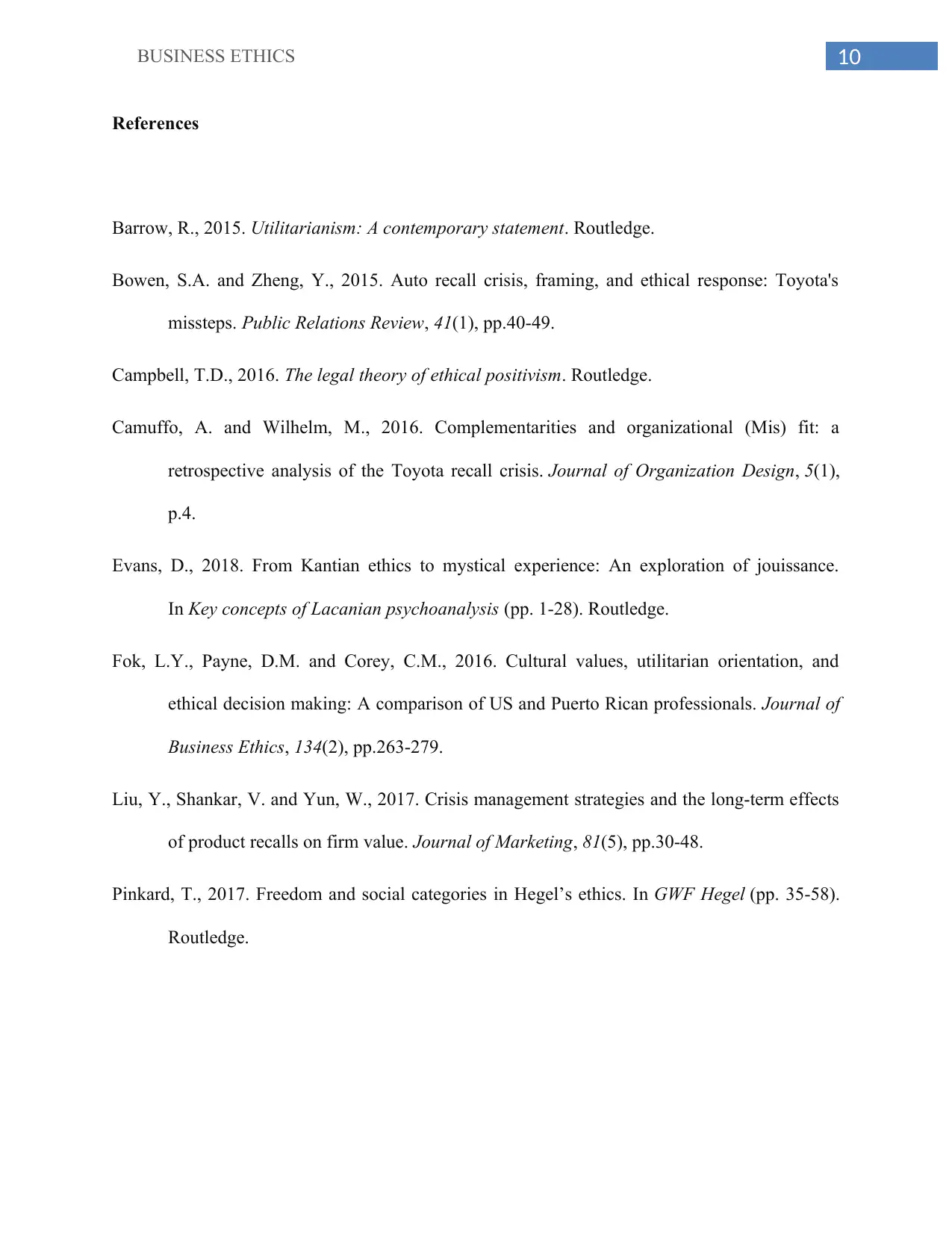
10BUSINESS ETHICS
References
Barrow, R., 2015. Utilitarianism: A contemporary statement. Routledge.
Bowen, S.A. and Zheng, Y., 2015. Auto recall crisis, framing, and ethical response: Toyota's
missteps. Public Relations Review, 41(1), pp.40-49.
Campbell, T.D., 2016. The legal theory of ethical positivism. Routledge.
Camuffo, A. and Wilhelm, M., 2016. Complementarities and organizational (Mis) fit: a
retrospective analysis of the Toyota recall crisis. Journal of Organization Design, 5(1),
p.4.
Evans, D., 2018. From Kantian ethics to mystical experience: An exploration of jouissance.
In Key concepts of Lacanian psychoanalysis (pp. 1-28). Routledge.
Fok, L.Y., Payne, D.M. and Corey, C.M., 2016. Cultural values, utilitarian orientation, and
ethical decision making: A comparison of US and Puerto Rican professionals. Journal of
Business Ethics, 134(2), pp.263-279.
Liu, Y., Shankar, V. and Yun, W., 2017. Crisis management strategies and the long-term effects
of product recalls on firm value. Journal of Marketing, 81(5), pp.30-48.
Pinkard, T., 2017. Freedom and social categories in Hegel’s ethics. In GWF Hegel (pp. 35-58).
Routledge.
References
Barrow, R., 2015. Utilitarianism: A contemporary statement. Routledge.
Bowen, S.A. and Zheng, Y., 2015. Auto recall crisis, framing, and ethical response: Toyota's
missteps. Public Relations Review, 41(1), pp.40-49.
Campbell, T.D., 2016. The legal theory of ethical positivism. Routledge.
Camuffo, A. and Wilhelm, M., 2016. Complementarities and organizational (Mis) fit: a
retrospective analysis of the Toyota recall crisis. Journal of Organization Design, 5(1),
p.4.
Evans, D., 2018. From Kantian ethics to mystical experience: An exploration of jouissance.
In Key concepts of Lacanian psychoanalysis (pp. 1-28). Routledge.
Fok, L.Y., Payne, D.M. and Corey, C.M., 2016. Cultural values, utilitarian orientation, and
ethical decision making: A comparison of US and Puerto Rican professionals. Journal of
Business Ethics, 134(2), pp.263-279.
Liu, Y., Shankar, V. and Yun, W., 2017. Crisis management strategies and the long-term effects
of product recalls on firm value. Journal of Marketing, 81(5), pp.30-48.
Pinkard, T., 2017. Freedom and social categories in Hegel’s ethics. In GWF Hegel (pp. 35-58).
Routledge.
1 out of 10
Related Documents
Your All-in-One AI-Powered Toolkit for Academic Success.
+13062052269
info@desklib.com
Available 24*7 on WhatsApp / Email
![[object Object]](/_next/static/media/star-bottom.7253800d.svg)
Unlock your academic potential
Copyright © 2020–2025 A2Z Services. All Rights Reserved. Developed and managed by ZUCOL.





